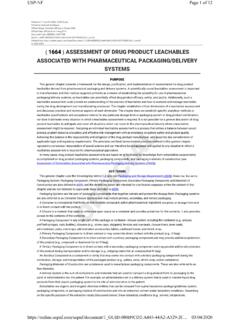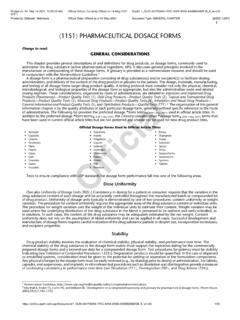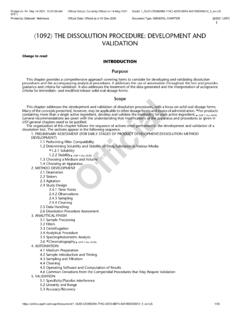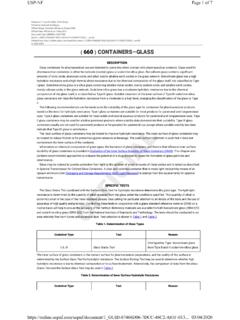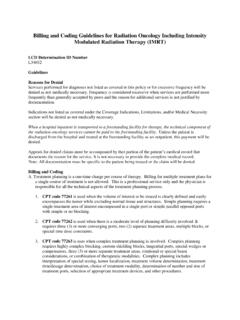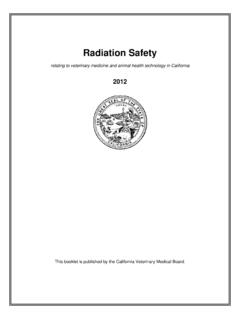Transcription of STERILIZATION OF COMPENDIAL ARTICLES
1 Printed on: Mon Mar 30 2020, 16:40:49 pmPrinted by: Deborah NishikawaOfficial Status: Currently Official on 30-Mar-2020 Official Date: Official as of 1-Aug-2013 Document Type: GENERAL CHAPTERDocId: 1_GUID-ECD53800-853C-40EB-9E08-F125CF4C9 99B_1_en-USPrinted from: 2020 USPC 1229 STERILIZATION OF COMPENDIAL ARTICLES BACKGROUND AND SCOPEThis general information chapter provides an overview of the concepts and principles involved in STERILIZATION (by various modes) of COMPENDIAL ARTICLES that must be sterile. It includes information about supportive STERILIZATION processes utilized in their preparation. More detailed recommendations are presented in specific information chapters for each STERILIZATION mode: Steam STERILIZATION by Direct Contact Moist Heat STERILIZATION of Aqueous Liquids Monitoring of Bioburden Sterilizing Filtration of Liquids Biological Indicators for STERILIZATION Liquid Phase STERILIZATION Gaseous STERILIZATION Dry Heat STERILIZATION Physicochemical Integrators and Indicators for STERILIZATION radiation STERILIZATION the use of biological indicators when appropriate.
2 All STERILIZATION processes should be maintained in a state of validation that includes periodic requalification. The validation program for each type of STERILIZATION comprises several formally documented stages. The general principles of validation programs are applicable to all STERILIZATION procedures. Individual details are presented in the specific USPinformational chapters for each STERILIZATION mode. The process developmentstage investigates and establishes the operating parameters that define the controls that will be used for the STERILIZATION process. Portions of the cycle development can be performed in a laboratory setting. The installation qualificationstage establishes that equipment controls and other instrumentation are installed as specified and calibrated.
3 Documentation should demonstrate the acceptability of the required utilities such as steam, water, and air. The operational qualificationstage confirms that the equipment functions within the defined STERILIZATION parameters. The performance qualificationstage of the validation program directly evaluates the STERILIZATION of materials or ARTICLES . This determination requires independent parameter measurement during the STERILIZATION process, as well as biological challenges in operational configurations. Correlation between the physical measurements and the demonstrated microbiological lethality or removal capability for sterilizing filtration methods supports the effectiveness of the STERILIZATION process.
4 The routine process controlstage of the STERILIZATION process requires a number of supportive practices and is outlined in detail below. 1 Page 1 of 6 USP-NF30/03/2020 AND JUSTIFYING STERILIZATION PROCESSES THAT RELY ON MICROBIAL INACTIVATIONA rticles intended to be sterile must attain a 10 probability of a nonsterile unit, , less than or equal to one chance in one million that viable bioburdenmicroorganisms are present. [NOTE This is also called the Sterility Assurance Level. The term Probability of a Nonsterile Unit(PNSU) is used throughout this chapter because it is descriptive and substantially easier to understand.] This PNSU can be accomplished by balancing the method effect on the materials and the destruction of the bioburden (see Figure 1).
5 Three methods are currently in use: overkill, bioburden/biological indicator, and bioburden-based methods. These methods are described in greater detail below. Regardless of the method chosen, the objective is a maximum PNSU of 10 for the bioburden. An overkill method is the simplest method to establish but has the greatest impact on materials. The bioburden-based method requires the most method control but subjects the materials to the least stressful conditions. Confidence in the process's lethality is the same, regardless of the method utilized. relative method in which bioburden samples from the material are routinely evaluated for resistance to the STERILIZATION process and may be utilized to demonstrate the effectiveness of the process.
6 Routine monitoring of the bioburden population and its resistance to the STERILIZATION process is STERILIZATION of liquids and gases differs from other STERILIZATION modes because filtration relies on removal of microorganisms from the fluid rather than inactivation by chemical or physical means. D-Value and Microbial ResistanceThe D-value is the time (customarily in minutes) or radiation dose (customarily in kGy) required to reduce the microbial population by 90% or 1 log cycle ( , to a surviving fraction of 1/10) and must be associated with the specific lethal conditions at which it was determined (see Figure 2). For steam and dry heat, the D-value is a function of temperature.
7 In gas STERILIZATION (ethylene oxide, ClO , or O ), D-values are a function of the chemical concentration, relative humidity, and temperature. Similarly, for liquid chemical STERILIZATION the D-value is a function of the temperature and sterilant concentration. [NOTE Determining the D-value for vapor (condensing) systems such as H O , H O plasma, and peracetic acid is complex because of the biphasic nature of the materials. radiation and filtration STERILIZATION are validated using unique methods. These processes are validated by methods that differ from those in this introductory chapter.] 6 610232 22 2 Page 2 of 6 USP-NF30/03/2020 2. Graphical representation of D-value.
8 The D-value is not an inherent attribute of the microbe only, so the influence of other factors such as substrate, matrix, recovery media, and test methodology must be considered in D-value determination. The resistance of a biological indicator is defined for the indicator as a system. Accurate assessment and comparison between D-values requires standardization of test methods. To properly evaluate the effectiveness of a STERILIZATION process, analysts must evaluate the resistance of the bioburden experimentally or via a literature search. Figure 3): curve region the death curve. approximately 10 CFU. This can region negative method is Figure 3by the Figure 3.
9 Death curve showing the various regions. As stated earlier, the goal of the STERILIZATION process is inactivation of the bioburden without adversely affecting product quality attributes. Demonstration of the lethality of a STERILIZATION process under routine operation relies on differences in the relative resistance and population of the bioburden relative to the biological indicator (see Figure 4). Where the overkill method is used, bioburden controls can be less rigorous. Page 3 of 6 USP-NF30/03/2020 4. Relative resistance and population of typical biological indicator and bioburden microorganisms. Validation of STERILIZATION processes links physical measurements with biological indicator performance to establish method lethality.
10 [NOTE In radiation STERILIZATION bioburden response is linked to physical irradiation dosage measurements.]Knowledge of the method's effectiveness coupled with bioburden controls on the materials under processing and information on bioburden resistance allow determination of the probability of a nonsterile unit. be considered. STERILIZATION processes. process. They are of minimal use in directly establishing process efficacy. STERILIZATION integrators are more sophisticated devices that react quantitatively in response to one or more of the critical STERILIZATION parameters and yield a result that can be correlated to lethality. The most sophisticated integrators are radiation dosimeters that are so accurate and robust that their use has displaced the use of biological indicators for the validation of radiation STERILIZATION .

